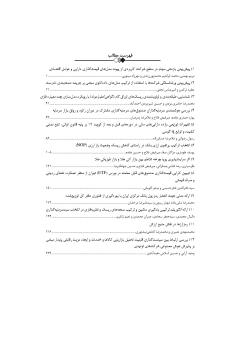پیش بینی ورشکستگی شرکتها با استفاده از ترکیب مدلهای داده کاوی مبتنی بر جریمه دسته بندی نادرست
پیش بینی ورشکستگی شرکتها با استفاده از ترکیب مدلهای داده کاوی مبتنی بر جریمه دسته بندی نادرست
محورهای موضوعی : مهندسی مالی
عطیه ترکمن 1 , امیرعباس نجفی 2 *
1 - گروه مهندسی مالی، دانشکده مهندسی صنایع، دانشگاه صنعتی خواجه نصیرالدین طوسی، تهران، ایران
2 - گروه مهندسی مالی، دانشکده مهندسی صنایع، دانشگاه صنعتی خواجه نصیرالدین طوسی، تهران، ایران
کلید واژه: ماشین بردار پشتیبان, پیشبینی ورشکستگی, دادهکاوی, k-نزدیکترین همسایه, ضرایب جریمه,
چکیده مقاله :
یکی از ابزارهای قدرتمند در مسائل پیش بینی ورشکستگی که در دهه های اخیر مورد توجه بسیاری از سرمایه گذاران، مدیران و محققان قرارگرفته است؛ داده کاوی و به طور خاص ماشین بردار پشتیبان است. اما مطالعات نشان می دهد این روش نسبت به انتخاب پارامترها و متغیرهای ورودی از حساسیت بالایی برخوردار است. لذا هدف از تحقیق حاضر ترکیب مدل توسعه یافته ماشین بردار پشتیبان و k-نزدیکترین همسایه جهت حذف ورودی های دارای خطا و متعاقبا افزایش دقت پیش بینی ورشکستگی است. به این منظور ابتدا با استفاده از 5 نسبت مالی شامل نسبت جاری، حاشیه سود خالص، نسبت بدهی، بازده دارایی ها و بازده سرمایه مرتبط به 150 شرکت حاضر در بورس اوراق بهادار تهران در بازه 10 ساله 1389-1398و الگوریتم k-نزدیکترین همسایگی داده های آموزش پالایش شده و سپس با تکیه بر ماشین بردار پشتیبان مبتنی بر جریمه دسته بندی، جهت ساخت مدل پیش بینی به کار گرفته می شوند. پس از برآورد پارامترهای بهینه، اعتبارسنجی مدل با استفاده از داده های آزمایش صورت خواهد گرفت. در نهایت نتایج بدست آمده از مدل پیشنهادی و مدل های کلاسیک مورد مقایسه قرار خواهدگرفت. نتایج نشان می دهد با ترکیب مدل های k-نزدیکترین همسایه و ماشین بردار پشتیبان خطای کلی پیش بینی کاهش یافته و ضرایب جریمه ماشین بردار پشتیبان با سطح احتمال بالایی معنادار هستند.
In recent years, data mining, particularly the support vector machine, has gained considerable interest among investors, managers, and researchers as an effective means of bankruptcy prediction. However, studies indicate that it is highly sensitive to the selection of parameters and input variables. Hence, the aim of this research is to improve bankruptcy prediction accuracy by combining an advanced support vector machine model with the k-nearest neighbor approach to eliminate erroneous entries. To achieve this, first, by using five financial ratios: current ratio, net profit margin, debt ratio, return on assets, and return of investment from 150 companies listed on the Tehran Stock Exchange during the 10-year period (2010-2019), and k-nearest neighbor algorithm, the training data will be refined. Then, relying on a support vector machine based on classification penalty, a prediction model will be constructed. The parameters will be estimated, and its validity will be assessed using test data. Finally, a comparison will be made between the outcomes of the proposed model and traditional models.The findings demonstrate that the combination of the k-nearest neighbor models and support vector machine reduces the overall prediction error, and the penalty coefficients of the support vector machine exhibit a high level of statistical significance.
_|Asghari, Zahra & Esfahanipour (2019) Introducing a model for forecasting corporate bankruptcy by integrating the particle swarm optimization algorithm with support vector machine. The fourth national conference in management, Tehran.
Altman, Edward (1968) Financial ratios, discriminant analysis and the prediction of corporate bankruptcy. The journal of finance, 23,4, 589-609.
Barboza, Kimura, & Altman (2017) Machine learning models and bankruptcy prediction. Expert Systems with Applications, 83, 405-417.
Beaver, William H (1966) Financial ratios as predictors of failure. Journal of accounting research, 71- 111.
Burges, Christopher (1998) A tutorial on support vector machines for pattern recognition. Data Mining and Knowledge Discovery, 2, 955–974.
Chen, Ning, & Vieira (2009) Bankruptcy Prediction based on Independent Component Analysis. In ICAART (pp. 150-155).
Deakin, Edward (1976) A discriminant analysis of predictors of business failure. Journal of Accounting Research, 167–179.
Ghazanfari, Mahdi, Rahimikia, Askari (2018) bankruptcy prediction of companies based on hybrid intelligent systems. Financial accounting and audit researches, 10, 37, 159-194.
Kim, Kang (2012) classifiers selection in ensembles using genetic algorithms for bankruptcy prediction. Expert systems with Applications,39,9308-9314.
Li, Xiaohui, Yang, Fan, Yu & Chen (2018) Discrimination of soft tissues using laser-induced breakdown spectroscopy in combination with k nearest neighbors (KNN) and support vector machine (SVM) classifiers. Optics & Laser Technology, 102, 233-239.
Liang, Ting-peng, Chandler, & Han (1990) Integrating statistical and inductive learning methods for knowledge acquisition. Expert Systems with Applications, 1, 4, 391-401.
Naserzade, Houshang (1995) Business Law. Didar publication, Tehran.
Ohlson, James A (1980) Financial ratios and the probabilistic prediction of bankruptcy. Journal of accounting research, 109-131.
Qu, Yi, Quan, Lei & Shi (2019) Review of bankruptcy prediction using machine learning and deep learning techniques. Procedia Computer Science, 162, 895-899.
Tian, Yingjie, Qi (2014) Review on: twin support vector machines. Annals of Data Science, 1, 2, 253-277.
Tomar, Divya, Agarwal (2015) Twin support vector machine: a review from 2007 to 2014. Egyptian Informatics Journal, 16, 1, 55-69
Van Gestel, Tony et al (2003) Bankruptcy prediction with least squares support vector machine classifiers, IEEE International Conference on Computational Intelligence for Financial Engineering, 1-8.
Vapnik, Vladimir N (1995) The nature of statistical learning theory. Springer science & business media, New York.
|_

